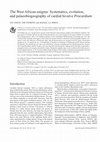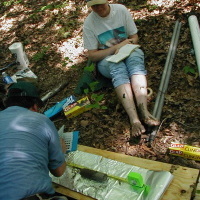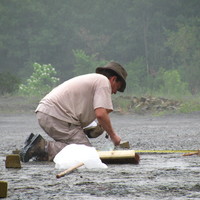Papers by Jan Johan ter Poorten
Vepricardium vidali spec. nov. is described from the Indo-West Pacific.
Basteria, Nov 9, 2019
Papyridea clenchi spec. nov. (Cardiidae) is described from Martinique and compared with the relat... more Papyridea clenchi spec. nov. (Cardiidae) is described from Martinique and compared with the related Papyridea lata (Born, 1778), Papyridea soleniformis (Bruguière, 1789) and Papyridea semisulcata (Gray, 1825). Papyridea curvicostata spec. nov. is described from Ecuador and compared with the related Papyridea hiulca (Reeve, 1845), Papyridea crockeri (A.M. Strong & Hertlein, 1937) and Papyridea aspersa (G.B. Sowerby I, 1833). Taxonomic relations within the four tropical Atlantic and four tropical eastern Pacific species are analyzed. Distributions of the living species are given. Atlantic-Pacific geminate species pairs are discussed; a predominantly one-way migration (from Atlantic to Pacific) through the Isthmus of Panama is hypothesized. The fossil record of Papyridea is reviewed and the taxonomic position of Profulvia is discussed.
Basteria 83 (1-3): 41-51., 2019
Americardia lindamaesae spec. nov. (Cardiidae) is described from Ascension Island, based on new c... more Americardia lindamaesae spec. nov. (Cardiidae) is described from Ascension Island, based on new collections. It is compared with the related Americardia media (Linnaeus, 1758), A. lightbourni Lee & Huber, 2012, A. columbella Lee & Huber, 2012 and A. speciosa (A. Adams & Reeve, 1850).

Defining and recording the loss of species diversity is a daunting task, especially if identities... more Defining and recording the loss of species diversity is a daunting task, especially if identities of species under threat are not fully resolved. An example is the Pontocaspian biota. The mostly endemic invertebrate faunas that evolved in the Black Sea -Caspian Sea -Aral Sea region and live under variable salinity conditions are undergoing strong change, yet within several groups species boundaries are not well established. Collection efforts in the past decade have failed to produce living material of various species groups whose taxonomic status is unclear. This lack of data precludes an integrated taxonomic assessment to clarify species identities and estimate species richness of Pontocaspian biota combining morphological, ecological, genetic, and distribution data. In this paper, we present an expert-working list of Pontocaspian and invasive mollusc species associated to Pontocaspian habitats. This list is based on published and unpublished data on morphology, ecology, anatomy, and molecular biology. It allows us to (1) document Pontocaspian mollusc species, (2) make species richness estimates, and (3) identify and discuss taxonomic uncertainties. The endemic Pontocaspian mollusc species richness is estimated between 55 and 99 species, but there are several groups that may harbour cryptic species. Even though the conservation status of most of the species is not assessed or data deficient, our observations point to deterioration for many of the Pontocaspian species.
Basteria, 2017
Fulvia kaarei spec. nov. (Cardiidae) is described from various localities in Vietnam. It is compa... more Fulvia kaarei spec. nov. (Cardiidae) is described from various localities in Vietnam. It is compared with the related Fulvia nienkeae ter Poorten, 2012, and with Fulvia australis (G.B. Sowerby II, 1834). Laevifulvia Vidal, 1994, is synonymised with Fulvia J.E. Gray, 1853.

Records of the Western Australia Museum, 2017
— Cardiids or marine cockles are one of the best known families of marine bivalves in the world, ... more — Cardiids or marine cockles are one of the best known families of marine bivalves in the world, with a long history of study and collection given their large and accessible shells, a tractable level of biodiversity globally (~290 species) and a solid fossil record extending to the late Triassic. In Western Australia, the cardiids are well known relative to other marine bivalve families, having been the subject of focussed treatment and consist of 31 species. However, given the proximity to the Indo-West Pacific, sheer size of the state and almost unparalleled number of habitats, the diversity is likely underestimated. Over the last 40 years, ongoing expedition work coupled with taxonomic study by the authors, has resulted in a doubling of the cardiid fauna of Western Australia (WA). Current cardiid diversity now stands at 68 species, including seven species of giant clams (Tridacninae). Subfamilial representation has changed little (except for the addition of Tridacninae previously in its own family, the Tridacnidae), and key genera in Cardiinae (e.g. Fulvia), Fraginae (e.g. Fragum) and Trachycardiinae (e.g. Acrosterigma and Vasticardium) still deliver much of the diversity. This updated biodiversity census has implications within and beyond Western Australia, with 16 new species records for the state and 14 new records for Australia, including four new species: Acrosterigma extremattenuatum sp. nov., Ctenocardia pilbaraensis sp. nov., Microcardium scabrosum sp. nov. and Pratulum occidentale sp. nov. Further taxonomic decisions include recognition of Vasticardium serricostatum (Melvill & Standen, 1899) and Lunulicardia tumorifera (Lamarck, 1819) as distinct species. Vasticardium swanae Maxwell, Congdon & Rymer, 2016 is considered a new synonym of Cardium variegatum G.B. Sowerby II, 1840; Vasticardium lomboke Vidal, 2003 is considered a new synonym of Cardium mindanense Reeve, 1844 and Acrosterigma abrolhense Vidal, 1999 is considered a new synonym of Cardium cygnorum Deshayes, 1855. All subspecies in the Vasticardium elongatum (Bruguière, 1789) complex are raised to species level.
New acquisitions arising from tropical survey work in the north have yielded all of the newly added species and all newly described species in the Western Australian Museum (WAM) cardiid collections. This is in contrast to the relatively stable biodiversity of southwestern Western Australia. In the north, diversity is highly structured with sixteen taxa found restricted to offshore islands and shoals (e.g. Vasticardium philippinense (Hedley, 1899), V. elongatum (Bruguière, 1789), Corculum cardissa (Linnaeus, 1758), Ctenocardia fornicata (G.B. Sowerby II, 1840), C. gustavi Vidal & Kirkendale, 2007), and a smaller cohort found exclusively inshore (e.g. A. extremattenuatum sp. nov., V. wilsoni (Voskuil & Onverwagt, 1991), C. pilbaraensis sp. nov.). Biodiversity comparisons are made with other tropical states in northern Australia, including the Northern Territory (NT) and Queensland (Qld), and considered together these records support recognition of a vast Dampierian Province. Regional biogegraphic comparisons are also made to examine whether cardiids in northern Australia are as diverse as other central Indo West Pacific (IWP) areas. To improve management of the commercially important Tridacninae (giant clams), we provide the first formal records of species diversity and distribution in this group for WA. While cardiids are relatively well characterised, persistent gaps remain that are not unique to this family. Our knowledge of small and/or cryptic species, as well as the deep water fauna broadly, lags behind our understanding of shallow water macromolluscs.

Poorten, J.J. ter and La Perna, R. 2017. The West African enigma: Systematics, evolution, and pal... more Poorten, J.J. ter and La Perna, R. 2017. The West African enigma: Systematics, evolution, and palaeobiogeography of cardiid bivalve Procardium. Acta Palaeontologica Polonica 62 (4): 729–757. Procardium gen. nov. is proposed for a group of early Miocene to Recent large cardiids in the subfamily Cardiinae. The type species is Cardium indicum, the only living representative, previously assigned to the genus Cardium. It is a mainly West African species, with a very limited occurrence in the westernmost Mediterranean. Procardium gen. nov. and Cardium differ markedly with regard to shell characters and have distinct evolutionary and biogeographic histories. Six species, in the early Miocene to Pleistocene range, and one Recent species are assigned to the new genus: Procardium magnei sp. nov., P. jansseni sp. nov., P. danubianum, P. kunstleri, P. avisanense, P. diluvianum, and P. indicum. During the Miocene, Procardium gen. nov. had a wide distribution in Europe, including the Proto-Mediterranean Sea, Western and Central Paratethys and NE Atlantic, with a maximum diversity during the Langhian and Serravallian. Its palaeobio-geographic history was strongly controlled by climate. During the Langhian stage, warm conditions allowed the genus to reach its highest latitude, ca. 54° N, in the southern North Sea Basin. With cooling, its latitudinal range gradually retreated southward, becoming mainly Mediterranean in the Pliocene–Pleistocene, and West African at present.
Basteria, 2017
Acrosterigma suluanum Vidal, 1999, was described based on much worn material from Sulu Archipelag... more Acrosterigma suluanum Vidal, 1999, was described based on much worn material from Sulu Archipelago, Philippines and Japan, collected more than a century ago. Due to the find of fresh and live Japanese material, additional morphological data are provided, a redescription is given and new distribution data are recorded. Additionally, its occurrence in Japanese Pleistocene deposits is documented.
Basteria, 2016
Frigidocardium centumliratum (Melvill in Melvill & Standen, 1907), F. helios ter Poorten & Poutie... more Frigidocardium centumliratum (Melvill in Melvill & Standen, 1907), F. helios ter Poorten & Poutiers in ter Poorten, 2009, and F. kiranum Sakurai & Habe, 1966, are for the first time reported from the Red Sea. Former Red Sea records of F. exasperatum (G.B. Sowerby II, 1839) and F. torresi (E.A. Smith, 1885) are considered misidentifications and, lacking any other records, are excluded from the Red Sea malacofauna. The type material of F. centumliratum is a composite of three species, hence a lectotype is designated to settle the taxonomic confusion.
Basteria, 2002
Vepricardium vidali spec. nov. is described from the Indo-West Pacific.
Basteria, 1997
The validity of Acrosterigma sewelli is demonstrated and a comparison is made with A. flava. A de... more The validity of Acrosterigma sewelli is demonstrated and a comparison is made with A. flava. A detailed description and new data on the distribution are given. Relationships with other Acrosterigma species are discussed and diagnostic features are given.
Basteria, 2015
Fragum vanuatuense spec. nov. (Cardiidae) is described from various localities in the central Ind... more Fragum vanuatuense spec. nov. (Cardiidae) is described from various localities in the central Indo-West Pacific. It represents the smallest Fragum and is compared with F. grasi Ter Poorten, 2009 and F. sueziense (Issel, 1869), both occurring partly sympatric with F. vanuatuense spec. nov. Figures of the juvenile growth stages of six Fragum species are given for comparison.

Reconstructing historical biogeography of the marine realm is complicated by indistinct barriers ... more Reconstructing historical biogeography of the marine realm is complicated by indistinct barriers and, over deeper time scales, a dynamic landscape shaped by plate tectonics. Here we present the most exten- sive examination of model-based historical biogeography among marine invertebrates to date. We con- ducted the largest phylogenetic and molecular clock analyses to date for the bivalve family Cardiidae (cockles and giant clams) with three unlinked loci for 110 species representing 37 of the 50 genera. Ancestral ranges were reconstructed using the dispersal–extinction–cladogenesis (DEC) method with a time-stratified paleogeographic model wherein dispersal rates varied with shifting tectonics. Results were compared to previous classifications and the extensive paleontological record. Six of the eight prior subfamily groupings were found to be para- or polyphyletic. Cardiidae originated and subsequently diversified in the tropical Indo-Pacific starting in the Late Triassic. Eastern Atlantic species were mainly derived from the tropical Indo-Mediterranean region via the Tethys Sea. In contrast, the western Atlantic fauna was derived from Indo-Pacific clades. Our phylogenetic results demonstrated greater concordance with geography than did previous phylogenies based on morphology. Time-stratifying the DEC recon- struction improved the fit and was highly consistent with paleo-ocean currents and paleogeography. Lastly, combining molecular phylogenetics with a rich and well-documented fossil record allowed us to test the accuracy and precision of biogeographic range reconstructions.

Basteria 77 (4-6): 45-73, Dec 21, 2013
The genus NemocardiumMeek, 1876, is traditionally considered
a relic of the past.Morphometric an... more The genus NemocardiumMeek, 1876, is traditionally considered
a relic of the past.Morphometric and morphological analyses reveal that the well-known species N. bechei (Reeve, 1847) is in need of taxonomic reconsideration. In this paper, five species are recognized, three of which are new to science: N. bechei from Taiwan, Philippines and Indonesia; N. probatum (Iredale, 1927) from northernAustralia; N. australojaponicum spec. nov. from southern Japan and Korea; N. enigmaticum spec. nov. from the SouthWest Pacific and N. fulvum spec. nov. from Mozambique,Madagascar, Seychelles, India, Philippines and Vanuatu. All but the last species seem to occur perfectly parapatrically.With N. fulvum spec. nov., which is not confined to the Central Indo-Pacific but covers large parts of the Indian Ocean as well, the longitudinal range of Nemocardium is much wider than hitherto thought. A substitute lectotype is designated for Cardium bechei Reeve, 1847, and the New Zealand genus Varicardium Marwick, 1944, is synonymized with Nemocardium.
Basteria, Dec 28, 2012
"Fulvia (Fulvia) nienkeae spec. nov. (Cardiidae) is described
from various localities in the Cen... more "Fulvia (Fulvia) nienkeae spec. nov. (Cardiidae) is described
from various localities in the Central Indo-West Pacific. It is
compared with the similar, sympatric Fulvia (Fulvia) australis
(G.B. Sowerby II, 1834) and with the Pliocene Fulvia (Fulvia)
tegalense (Oostingh, 1934) comb. nov."
Basteria 75 (4-6): 104-106, Dec 21, 2011
"It is shown that Cardium leve Anton, 1838, should not be regarded
as a junior homonym of Cardiu... more "It is shown that Cardium leve Anton, 1838, should not be regarded
as a junior homonym of Cardium laeve Gray, 1838.
Following ICZN Art. 23.9.1, Cardium leve is herewith designated
as a nomen oblitum, and Cardium multispinosum G.B.
Sowerby II, 1839, as a nomen protectum."
Vita Malacologica 8: 9-96, Nov 21, 2009
Basteria 71 (1-3): 57-69, Nov 3, 2007
It is shown that what is generally considered a single species, the Great ribbed cockle, Cardium ... more It is shown that what is generally considered a single species, the Great ribbed cockle, Cardium costatum Linnaeus, 1758, consists of two clearly different forms, to be separated at species level. Among the available possible type material of C. costatum, which is in agreement with one of these forms, a lectotype is selected. Because no alternative name is available for the remaining form, a new species is here described as C. maxicostatum spec. nov.











Uploads
Papers by Jan Johan ter Poorten
New acquisitions arising from tropical survey work in the north have yielded all of the newly added species and all newly described species in the Western Australian Museum (WAM) cardiid collections. This is in contrast to the relatively stable biodiversity of southwestern Western Australia. In the north, diversity is highly structured with sixteen taxa found restricted to offshore islands and shoals (e.g. Vasticardium philippinense (Hedley, 1899), V. elongatum (Bruguière, 1789), Corculum cardissa (Linnaeus, 1758), Ctenocardia fornicata (G.B. Sowerby II, 1840), C. gustavi Vidal & Kirkendale, 2007), and a smaller cohort found exclusively inshore (e.g. A. extremattenuatum sp. nov., V. wilsoni (Voskuil & Onverwagt, 1991), C. pilbaraensis sp. nov.). Biodiversity comparisons are made with other tropical states in northern Australia, including the Northern Territory (NT) and Queensland (Qld), and considered together these records support recognition of a vast Dampierian Province. Regional biogegraphic comparisons are also made to examine whether cardiids in northern Australia are as diverse as other central Indo West Pacific (IWP) areas. To improve management of the commercially important Tridacninae (giant clams), we provide the first formal records of species diversity and distribution in this group for WA. While cardiids are relatively well characterised, persistent gaps remain that are not unique to this family. Our knowledge of small and/or cryptic species, as well as the deep water fauna broadly, lags behind our understanding of shallow water macromolluscs.
a relic of the past.Morphometric and morphological analyses reveal that the well-known species N. bechei (Reeve, 1847) is in need of taxonomic reconsideration. In this paper, five species are recognized, three of which are new to science: N. bechei from Taiwan, Philippines and Indonesia; N. probatum (Iredale, 1927) from northernAustralia; N. australojaponicum spec. nov. from southern Japan and Korea; N. enigmaticum spec. nov. from the SouthWest Pacific and N. fulvum spec. nov. from Mozambique,Madagascar, Seychelles, India, Philippines and Vanuatu. All but the last species seem to occur perfectly parapatrically.With N. fulvum spec. nov., which is not confined to the Central Indo-Pacific but covers large parts of the Indian Ocean as well, the longitudinal range of Nemocardium is much wider than hitherto thought. A substitute lectotype is designated for Cardium bechei Reeve, 1847, and the New Zealand genus Varicardium Marwick, 1944, is synonymized with Nemocardium.
from various localities in the Central Indo-West Pacific. It is
compared with the similar, sympatric Fulvia (Fulvia) australis
(G.B. Sowerby II, 1834) and with the Pliocene Fulvia (Fulvia)
tegalense (Oostingh, 1934) comb. nov."
as a junior homonym of Cardium laeve Gray, 1838.
Following ICZN Art. 23.9.1, Cardium leve is herewith designated
as a nomen oblitum, and Cardium multispinosum G.B.
Sowerby II, 1839, as a nomen protectum."
New acquisitions arising from tropical survey work in the north have yielded all of the newly added species and all newly described species in the Western Australian Museum (WAM) cardiid collections. This is in contrast to the relatively stable biodiversity of southwestern Western Australia. In the north, diversity is highly structured with sixteen taxa found restricted to offshore islands and shoals (e.g. Vasticardium philippinense (Hedley, 1899), V. elongatum (Bruguière, 1789), Corculum cardissa (Linnaeus, 1758), Ctenocardia fornicata (G.B. Sowerby II, 1840), C. gustavi Vidal & Kirkendale, 2007), and a smaller cohort found exclusively inshore (e.g. A. extremattenuatum sp. nov., V. wilsoni (Voskuil & Onverwagt, 1991), C. pilbaraensis sp. nov.). Biodiversity comparisons are made with other tropical states in northern Australia, including the Northern Territory (NT) and Queensland (Qld), and considered together these records support recognition of a vast Dampierian Province. Regional biogegraphic comparisons are also made to examine whether cardiids in northern Australia are as diverse as other central Indo West Pacific (IWP) areas. To improve management of the commercially important Tridacninae (giant clams), we provide the first formal records of species diversity and distribution in this group for WA. While cardiids are relatively well characterised, persistent gaps remain that are not unique to this family. Our knowledge of small and/or cryptic species, as well as the deep water fauna broadly, lags behind our understanding of shallow water macromolluscs.
a relic of the past.Morphometric and morphological analyses reveal that the well-known species N. bechei (Reeve, 1847) is in need of taxonomic reconsideration. In this paper, five species are recognized, three of which are new to science: N. bechei from Taiwan, Philippines and Indonesia; N. probatum (Iredale, 1927) from northernAustralia; N. australojaponicum spec. nov. from southern Japan and Korea; N. enigmaticum spec. nov. from the SouthWest Pacific and N. fulvum spec. nov. from Mozambique,Madagascar, Seychelles, India, Philippines and Vanuatu. All but the last species seem to occur perfectly parapatrically.With N. fulvum spec. nov., which is not confined to the Central Indo-Pacific but covers large parts of the Indian Ocean as well, the longitudinal range of Nemocardium is much wider than hitherto thought. A substitute lectotype is designated for Cardium bechei Reeve, 1847, and the New Zealand genus Varicardium Marwick, 1944, is synonymized with Nemocardium.
from various localities in the Central Indo-West Pacific. It is
compared with the similar, sympatric Fulvia (Fulvia) australis
(G.B. Sowerby II, 1834) and with the Pliocene Fulvia (Fulvia)
tegalense (Oostingh, 1934) comb. nov."
as a junior homonym of Cardium laeve Gray, 1838.
Following ICZN Art. 23.9.1, Cardium leve is herewith designated
as a nomen oblitum, and Cardium multispinosum G.B.
Sowerby II, 1839, as a nomen protectum."